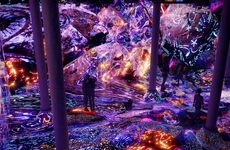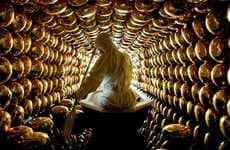
Chris Saunter Cuts Through Walls to See the Stars
Ana Lopez — November 8, 2011 — Art & Design
References: chrissauter & thisiscolossal
To admire the Milky Way and other celestial bodies, it’s not necessary to go outdoors or to have the most technologically advanced equipment, as shown by American artist Chris Saunter who created his own scientific lab and Nasa-inspired space using walls. Sauter cut out pieces from drywall and used other materials to construct a telescope and a microscope.
This stellar creation, titled ‘The Whole World,’ resulted in two fantastic masterpieces and two walls that simulate both a constellation and a surface full of bacteria-like forms. The pieces were extracted from a white gallery wall; one wall was exclusively designed to create the star-gazing machine, and the other was for the microscope.
Both installations and respective walls produced by Chris Saunter constitute a fascinating visual game that proves that art, science and astronomy can harmoniously work together.
This stellar creation, titled ‘The Whole World,’ resulted in two fantastic masterpieces and two walls that simulate both a constellation and a surface full of bacteria-like forms. The pieces were extracted from a white gallery wall; one wall was exclusively designed to create the star-gazing machine, and the other was for the microscope.
Both installations and respective walls produced by Chris Saunter constitute a fascinating visual game that proves that art, science and astronomy can harmoniously work together.
Trend Themes
1. Cardboard Telescope Installations - Opportunity for artists to merge art, science, and astronomy through unconventional creations.
2. DIY Lab Creations - Potential for individuals to build their own scientific equipment using unconventional materials.
3. Interactive Gallery Installations - Trend for immersive experiences that blend various disciplines, such as art, science, and technology.
Industry Implications
1. Art - Artists can explore innovative and unconventional materials to create unique installations.
2. Science Education - Educational institutions and programs can encourage hands-on experimentation and creativity in scientific learning.
3. Astronomy - Opportunities exist for merging art and science in the field of astronomy, creating immersive and engaging experiences.
3.5
Score
Popularity
Activity
Freshness























